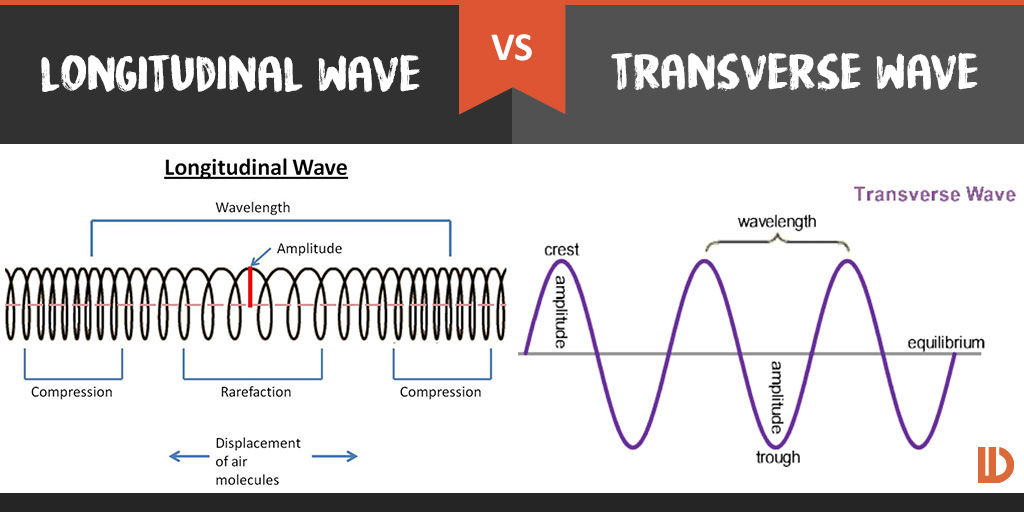How Are Transverse and Longitudinal Waves Alike and Different
How are transverse and longitudinal waves similar. For transverse waves the waves move in perpendicular direction to the source of vibration.

Difference Between Longitudinal And Transverse Wave With Its Practical Applications In Real Life
They are similar in the sense that energy is transferred in the.

. For longitudinal waves the waves move in parallel direction to the source of vibration. For transverse waves the waves move in perpendicular direction to the source of vibration. Transverse waves cannot travel through liquids and gaseous matter but only the solids but Longitudinal waves cannot only travel through solids but also gas and liquid objects.
Transverse waves comprise the most relevant examples in physics. Usually they do not displace matter in a permanent way and their properties such as frequency and amplitude are easily visualised. Traverse waves are made of troughs and crests.
The main difference between transverse and longitudinal waves is that in transverse waves oscillations occur perpendicular to the direction of propagation of the wave whereas in longitudinal waves oscillations occur parallel to the direction of propagation of the wave. For longitudinal waves the waves move in parallel direction to the source of vibration. They are similar in the sense that energy is transferred in the form of waves.
Longitudinal waves are those in which the oscillations are parallel to the waves travel direction. The Transverse and Longitudinal waves are created through different processes. Such a wave is called a Longitudinal wave.
There are only two types of mechanical waves. They are similar in the sense that energy is transferred in the. Similar-For transverse waves the waves move in perpendicular direction to the source of vibration.
How are they different. For transverse waves the waves move in the perpendicular direction to the source of vibration. A typical example is a longitudinal wave is a sound wave or shock wave.
Longitudinal waves usually have to do with matter transferring the movement of the wave to nearby particles in a pressure-like way. For transverse waves the waves move in perpendicular direction to the source of vibration. Similarities between longitudinal wave and transverse wave 1 They travel in a medium with constant speed which is different in different media.
2 They obey the laws of reflection and refraction. Longitudinal waves are mechanical waves that require a medium for propagation transverse waves are non-mechanical waves that do not require a medium for propagation. Longitudinal waves consist of compressions and rarefactions while.
For transverse waves the waves move in perpendicular direction to the source of vibration. For longitudinal waves the waves move in parallel direction to the source of vibration. Longitudinal and transverse waves are mechanical waves so both carry energy through particles of matter.
Transverse and longitudinal waves are two different waves that have opposite characteristics. Find step-by-step Physical science solutions and your answer to the following textbook question. They are similar in the sense that energy is transferred in the form of waves.
Longitudinal waves and transverse wavesIn a longitudinal wave the waves themselves oscillate or. Transverse and longitudinal are two different types of waves. In transverse waves the particles move perpendicular to the direction of the wave and in longitudinal waves the particles move parallel to the direction of the wave.
6 rows In a longitudinal wave the medium or the channel moves in the same direction with respect to. A string or slinky lying horizontal and pushed horizontally is a simple way to demonstrate a longitudinal wave. Longitudinal waves transfer energy parallel to the direction of wave motion and transverse waves transfer energy perpendicular to the direction of.
For longitudinal waves the waves move in parallel direction to the source of vibration. Transverse waves and Longitudinal wave are very much different but they are related. One difference between longitudinal and transverse wave is with regards to dimension.
They are similar in the sense that energy is transferred in. Transverse waves have their electric magnetic orientation at right angles to one another whereas longitudinal waves have their electric and magnetic fields directed parallel. In contrast the transverse wave is one that acts in two dimensions.
For longitudinal waves the waves move in the parallel direction to the source of vibration. They are similar in the sense that energy is transferred in the. Longitudinal waves are made of rarefactions and compressions.
Study sets textbooks questions. A longitudinal wave has a compression increased intensity of the medium particles and a rarefaction a reduction of intensity. Furthermore the longitudinal wave is one that acts in one dimension.
For longitudinal waves the waves move in parallel direction to the source of vibration. Both of them also differ in terms of the matter they can travel through. Transverse waves have oscillations that are perpendicular to the waves travel direction.
The type of mechanical wave in which the oscillation of constituent elements of the medium is along the direction of propagation of the wave.

Transverse And Longitudinal Waves

What Is The Difference Between A Longitudinal Wave And A Transverse Wave Socratic

What Type Of Wave Is Sound Pasco Blog Pasco

6 Illustration Of A Transverse Wave And A Longitudinal Wave Download Scientific Diagram
No comments for "How Are Transverse and Longitudinal Waves Alike and Different"
Post a Comment